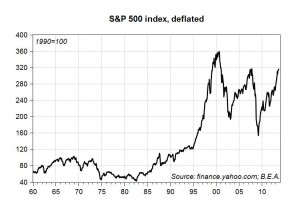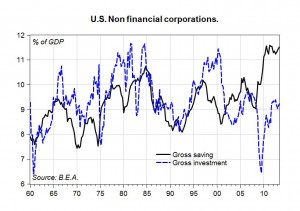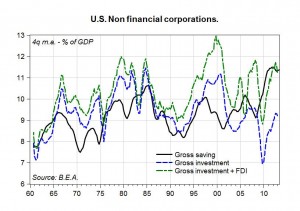The Next Bubble?
byIs the U.S. economy heading towards another bubble? Since last week, the number of commentators on this subject has been growing, from Robert Shiller to Nouriel Roubini (on housing markets).
In our first chart we report the Standard & Poor’s 500 stock market index, normalized by a consumer price index to remove the common trend in prices. Our measure has increased by 105.6 percent from its most recent bottom in March 2009. In the previous rally, which started from a bottom value in February 2003, the index increased by only 63 percent before the start of a rapid descent in July 2007.
Is a buoyant stock market justified by expected profitability? In the next chart, we report gross saving of non-financial corporations – that is, undistributed profits gross of capital consumption – scaled by GDP, along with gross investment (which includes changes in inventories). All figures are computed from the Integrated Macroeconomic Accounts published by the B.E.A.
The chart clearly shows that profits have reached an all-time high at 11.5 percent of GDP, compared to an average of 9 percent over the 1960-2007 period. If current profits are the basis for expected future profitability, our data suggest that the stock market rally is justified. But is this trend stable and sustainable?
The chart also shows what we may call an investment gap. While profits and investment have usually moved in line, it was usually the case that investment exceeded retained profits. But since the second half of 2008, profits have soared while investment dropped, opening a gap which is currently over 2 percent of GDP. A low level of investment is not a good sign for future growth.
What are companies doing with such exceptional profits? In the next chart we add U.S. foreign direct investment (FDI) made abroad to domestic investment in our previous chart (while at the same time switching to moving averages to reduce the volatility of quarterly FDI).
The new chart is suggesting that foreign direct investment is a major destination for retained profits, and that FDI did not suffer the same downturn seen in domestic investment during the last recession.
Data from the B.E.A. on the composition and direction of U.S. FDI show it is difficult to evaluate where U.S. foreign direct investment is directed. While data for FDI in manufacturing show the emerging role of China as recipient of U.S. FDI, its weight is still below 5 percent of total FDI in manufacturing. Besides, the share of manufacturing in total FDI in 2012 is only 14 percent, while multinational companies, classified as “Holding Companies (non bank)” in B.E.A. statistics, account for almost 44 percent of total FDI in 2012. Countries receiving FDI in this grouping seem to be financial centers: the Netherlands (25.6 percent), Luxembourg (15.5 percent), Bermuda (11.2 percent), and the U.K. (10.7 percent).
Summing up, our findings suggest that U.S. non-financial corporations are in a healthy state – as measured by their net profits – but that this will not necessarily imply stronger U.S. growth and job creation. On the contrary, the data are coherent with a further increase in the concentration of income leading to financial speculation, in the U.S. as well as in foreign financial markets.
Restoring jobs and prosperity in the U.S. does not seem to be what U.S. corporations are working towards, and yes, the soaring stock market may change course very quickly, if “financial markets” make this decision.
Restoring sustainable growth in the U.S. (and elsewhere) requires a reversal of the trend in income distribution, since, as Stockhammer reminds us, “rising inequality has increased the propensity to speculate as richer households tend to hold riskier financial assets than other groups,” and “higher inequality has led to higher household debt as working class families have tried to keep up with social consumption norms despite stagnating or falling real wages” – a fact we already investigated a few years ago.




